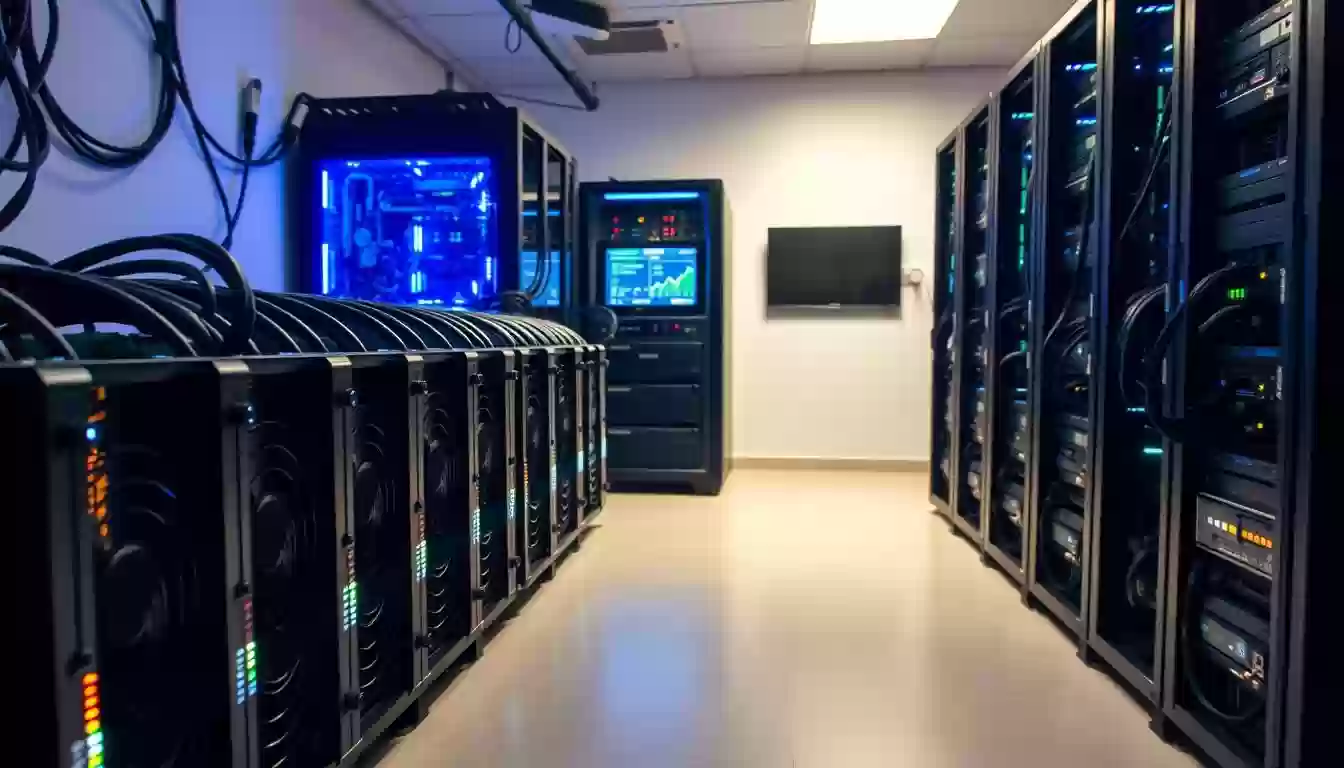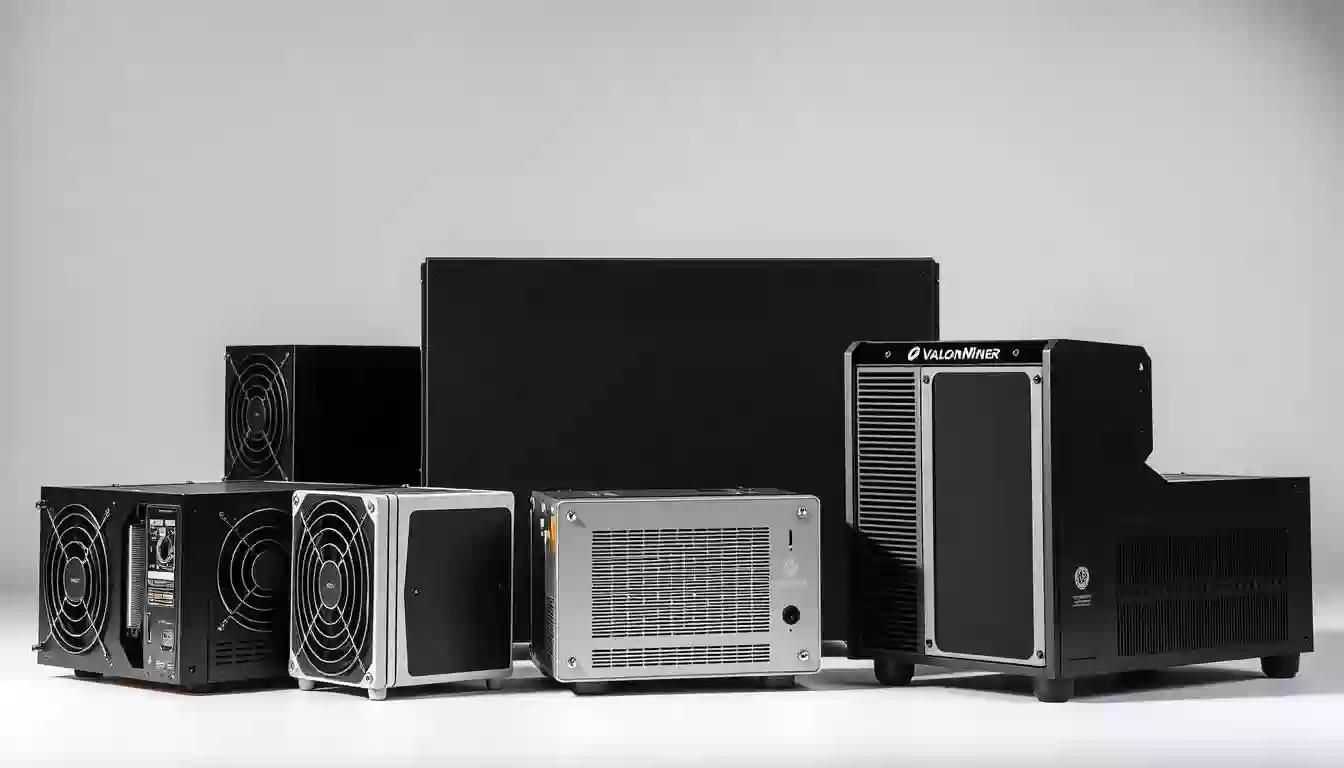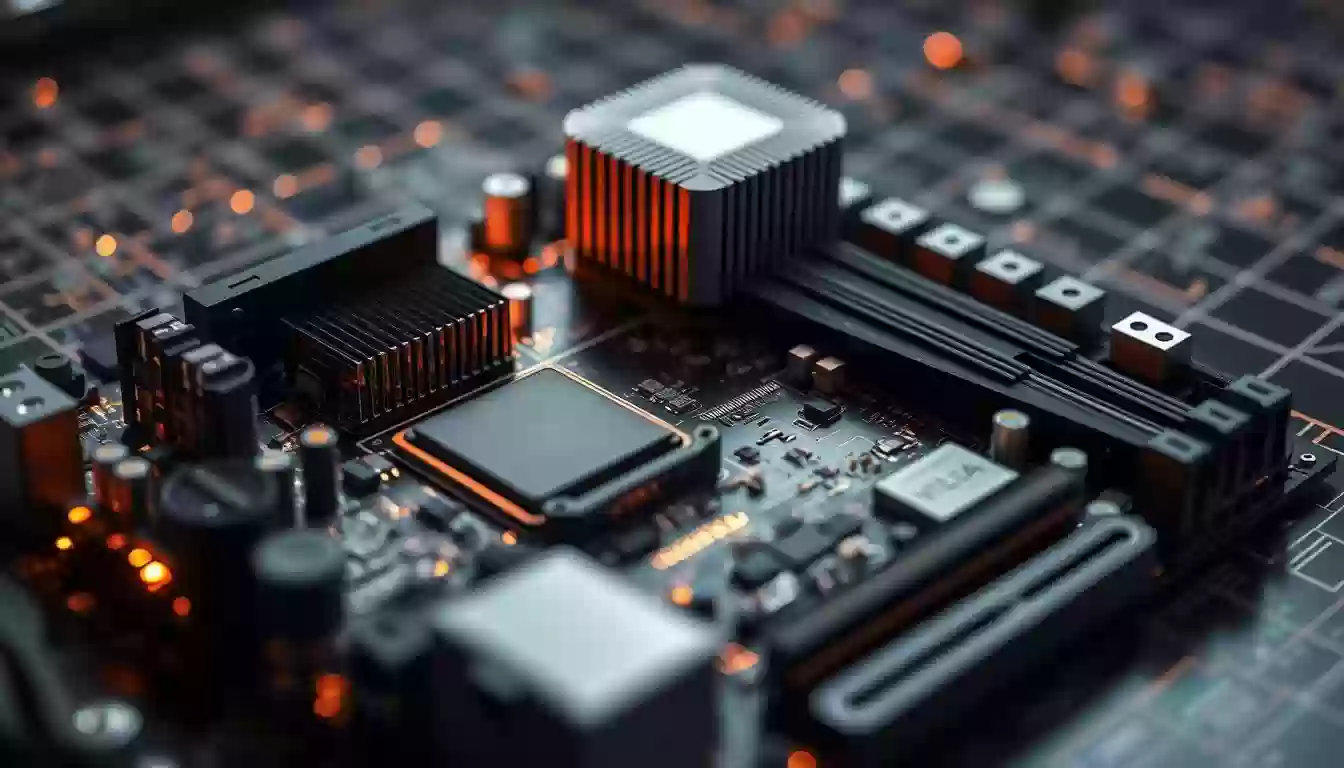Top-Rated Mining Hardware for Bitcoin | Expert Guide
 09 Mar 25
09 Mar 25
Welcome to our comprehensive guide on the top-rated mining hardware for Bitcoin in 2025. In this article, we will explore the latest advancements in ASIC technology and how they are shaping the future of Bitcoin mining. Whether you're a seasoned miner or just starting out, selecting the right machine is crucial for optimizing your performance in this competitive landscape.
Recent hash rate forecasts indicate a growing demand for high-efficiency models. The Bitmain Antminer S21 Pro, for instance, boasts an impressive 234 TH/s, while the WhatsMiner M30S delivers a reliable 170-186 TH/s. These machines are not just powerful; they are designed to adapt to the evolving needs of the mining industry.
Our expert reviews will dive into the technical specifications, cost-profit analyses, and real-world performance of these top models. We'll also discuss the latest trends in Bitcoin mining and what to expect from upcoming releases. By the end of this guide, you'll be well-equipped to make an informed decision on the best hardware for your needs.
Stay ahead in the race with cutting-edge technology and trusted insights. Let's explore the world of mining together and uncover the potential of these remarkable machines.
Learn more about the bestBitcoin mining and how to choose the right one for your operations.
Introduction to Bitcoin Mining Hardware Trends
The rapid growth in Bitcoin adoption has significantly impacted the demand for high-performance mining equipment. As more individuals and organizations enter the Bitcoin space, the need for efficient and powerful mining solutions has never been greater. This section explores the current trends shaping the mining hardware landscape.
Context and Growing Adoption
Bitcoin mining has evolved from a niche activity to a global industry. The increasing adoption of Bitcoin as a store of value and a medium of exchange has led to a surge in demand for specialized mining equipment. ASIC (Application-Specific Integrated Circuit) devices have become the standard for mining due to their superior efficiency and hash rate capabilities compared to traditional GPUs and CPUs.
Current Market Overview
The market for mining hardware is highly competitive, with major manufacturers like Bitmain, MicroBT, and Canaan leading the charge. These companies are continually innovating to produce models with higher hash rates and lower power consumption. The table below highlights some of the key models available in the market today.
| Manufacturer | Model | Hash Rate (TH/s) | Power Consumption (W) |
|---|---|---|---|
| Bitmain | Antminer S21 Pro | 234 | 3,510 |
| MicroBT | WhatsMiner M30S | 170-186 | 3,450-3,900 |
| Canaan | Avalon A1566 | 150 | 3,225 |
These advancements in ASIC technology have made mining more accessible and profitable for both individual miners and large-scale operations. However, the rising difficulty levels and electricity costs remain significant challenges for miners. As the Bitcoin network continues to grow, the demand for more efficient and cost-effective mining solutions will only intensify.
Exploring the Best Mining Hardware for Bitcoin
When it comes to selecting the right tools for maximizing your mining operations, understanding the latest advancements in mining technology is essential. Leading manufacturers like Bitmain and MicroBT have introduced cutting-edge models designed to deliver superior performance while optimizing energy use.
The Bitmain Antminer S21 Pro stands out with its impressive hash rate of 234 TH/s and power consumption of 3,510W. Similarly, the MicroBT WhatsMiner M60S offers a reliable hash rate range of 170-186 TH/s with power consumption between 3,450W and 3,900W. These models exemplify how modern mining machines are engineered to balance power and efficiency, making them ideal for both individual miners and large-scale operations.
When evaluating these bitcoin mining models, it's crucial to consider not only their technical specifications but also their cost-effectiveness and adaptability to current market conditions. For instance, the Antminer S21 Pro's higher hash rate may appeal to those prioritizing performance, while the WhatsMiner M60S offers flexibility with its variable hash rates. Both machines represent significant advancements in the field, ensuring miners can maintain profitability in a competitive landscape. For more insights, you can explore our detailed guide on top ASIC models and their performance metrics.
Key Specifications and Performance Metrics
Understanding the technical details of mining equipment is crucial for making informed decisions. This section breaks down the essential specs and how they impact performance.
Hashrate and Energy Efficiency
Hash rate measures a miner's computational power. A higher hash rate means better performance. For example, the Bitmain Antminer S21 Pro offers 234 TH/s. Energy efficiency, measured in J/TH, affects power consumption. The S21 Pro uses 15 J/TH, balancing performance and energy use.
Power Consumption and Daily Profitability
Power consumption is a major cost factor. The S21 Pro uses 3,510W, while the WhatsMiner M30S ranges from 3,450W to 3,900W. Calculating daily profitability involves hash rate, power cost, and network difficulty. Using real data, we can estimate profitability and compare models effectively.
Clarifying these metrics helps miners choose the right model, ensuring optimal performance and cost-effectiveness.
Detailed Reviews: Bitmain, MicroBT, and Canaan Models
Exploring the latest advancements in mining technology, we delve into the top models from leading manufacturers. Each brand offers unique strengths, shaping the future of this competitive field.
Notable Models from Bitmain
Bitmain's Antminer S21 Pro stands out with its impressive 234 TH/s hash rate and 15 J/TH efficiency. Designed for high performance, it's a top choice for both large-scale operations and serious hobbyists. The S19j Pro, another standout, offers consistent performance and durability, making it a reliable option for miners seeking stability.
Featured MicroBT and Canaan ASICs
MicroBT's WhatsMiner M60S delivers a flexible hash rate of 170-186 TH/s, supported by LuxOS firmware for enhanced customization. This model is ideal for miners needing adaptability. Canaan's Avalon A1566, with its 150 TH/s hash rate, is known for its energy efficiency and lower power consumption, appealing to those prioritizing cost-effectiveness.
| Model | Hash Rate (TH/s) | Power Consumption (W) | Efficiency (J/TH) |
|---|---|---|---|
| Bitmain Antminer S21 Pro | 234 | 3,510 | 15 |
| MicroBT WhatsMiner M60S | 170-186 | 3,450-3,900 | 18.5 |
| Canaan Avalon A1566 | 150 | 3,225 | 19.9 |
These models represent the pinnacle of innovation in mining technology, each offering unique advantages. Whether you're a hobbyist or managing a large operation, understanding these specifications is key to making informed decisions and optimizing your setup for success.

Air-Cooled versus Immersion-Cooled Systems
Cooling systems play a vital role in maintaining the performance and longevity of mining equipment. Two popular methods are air-cooled and immersion-cooled systems, each with distinct advantages and limitations.
Air-cooled systems, such as the Bitmain Antminer S21 Pro, rely on fans to circulate air and dissipate heat. These are cost-effective and easy to set up, making them ideal for smaller operations or home use. However, they can be noisier and may struggle with heat management in warmer environments.
On the other hand, immersion-cooled systems, like the WhatsMiner M66S, submerge the hardware in a coolant, offering superior heat transfer and reduced noise. This method is more efficient and prolongs hardware life but requires a higher initial investment and complex installation.
Manufacturer recommendations often guide the choice. Bitmain suggests air-cooled systems for simplicity, while MicroBT promotes immersion for larger-scale operations. Consider your setup size, budget, and climate when deciding between these options.
Efficiency, Cost, and Profitability Considerations
When evaluating mining equipment, understanding the financial aspects is crucial. Electricity costs and hardware efficiency directly impact your profitability. Let's explore how to calculate daily profits and analyze return on investment.
Electricity Costs and Profit Calculations
Electricity is a major expense in mining. To calculate daily profitability, consider hash rate, power consumption, and electricity cost. For example, the Bitmain Antminer S21 Pro has a hash rate of 234 TH/s and consumes 3,510W. At 6 cents per kWh, it yields a daily profit of $7.80.
Return on Investment Analysis
ROI analysis helps determine if a miner is profitable. High-power models may increase electricity bills but can also boost profits. Balancing upfront costs with long-term efficiency is key. The Antminer S21 Pro, despite higher initial costs, offers superior efficiency, leading to quicker ROI.
| Manufacturer | Model | Hash Rate (TH/s) | Power Consumption (W) | Daily Profit |
|---|---|---|---|---|
| Bitmain | Antminer S21 Pro | 234 | 3,510 | $7.80 |
| MicroBT | WhatsMiner M30S | 170-186 | 3,450-3,900 | $5.60-$6.40 |
| Canaan | Avalon A1566 | 150 | 3,225 | $4.50 |
When choosing hardware, consider your setup's specific needs. While high-efficiency models may cost more initially, they often provide better long-term returns. Always evaluate both the upfront investment and ongoing electricity costs to maximize profitability.
Latest ASIC Models and New Releases in 2025
The year 2025 has brought exciting advancements in ASIC technology, with several cutting-edge models hitting the market. These new releases are set to revolutionize the mining landscape, offering enhanced performance and efficiency.
One of the standout models is the Bitmain Antminer S21 XP Hydro, boasting an impressive 473 TH/s hash rate. This model not only delivers superior power but also features improved energy efficiency, making it a top choice for both individual miners and large-scale operations.
| Model | Hash Rate (TH/s) | Power Consumption (W) | Efficiency (J/TH) |
|---|---|---|---|
| Bitmain Antminer S21 XP Hydro | 473 | 3,900 | 8.2 |
| Avalon Q | 90 | 1,674 | 18.60 |
| Antminer S21+ Hydro | 319 | 4,785 | 15.00 |
Other notable releases include the Avalon Q and Antminer S21+ Hydro. The Avalon Q offers 90 TH/s with a power consumption of 1,674W, while the Antminer S21+ Hydro provides 319 TH/s and consumes 4,785W. These models exemplify the industry's shift towards more efficient and powerful solutions.
Early adopters of these models can expect improved profitability due to higher hash rates and better energy efficiency. As the mining landscape evolves, staying updated with the latest technology becomes crucial for maintaining a competitive edge.
Firmware and Software Enhancements for Mining Optimization
Firmware plays a crucial role in maximizing the performance of mining equipment. It acts as the brain of your mining machine, dictating how efficiently it operates. Whether you're using stock firmware or exploring third-party options, the right software can significantly enhance your mining efficiency and overall profitability.
Stock Firmware vs. Third-Party Options
Most mining machines come with stock firmware, designed by the manufacturer to provide a balanced performance. For instance, the Bitmain Antminer S21 Pro includes stock firmware that offers stable operation and consistent results. However, third-party firmware, like LuxOS, can unlock additional features and improve performance beyond what the stock version offers.
Custom Configurations and Performance Gains
Third-party firmware often allows for custom configurations, enabling miners to fine-tune settings such as fan speed, voltage, and clock rates. These adjustments can lead to improved hash rates and reduced power consumption. For example, using LuxOS on compatible models has been known to increase hash rates by up to 10% while lowering energy use.
Custom configurations can optimize energy efficiency, a critical factor in maintaining profitability. By tailoring settings to your specific mining environment, you can achieve better performance and reduce operational costs.

When considering firmware modifications, it's important to weigh the benefits against potential challenges. While "jailbreaking" your ASIC can lead to enhanced efficiency, it may also void your warranty or cause instability if not done correctly. Always follow manufacturer guidelines and consult trusted resources before making changes.
Choosing the right firmware is essential for maximizing your mining potential. Consider your specific needs and the level of customization you desire. Whether sticking with stock firmware or exploring third-party options, the goal is to optimize your mining machine for peak performance and profitability.
How to Choose the Right Mining Machine for Your Setup
Selecting the right mining machine requires careful consideration of both technical and financial factors. With so many options available, it's essential to evaluate based on performance, price, and efficiency to ensure optimal results for your setup.
Balancing Price and Performance
A key factor in choosing a mining machine is balancing the upfront cost with long-term profitability. High-performance models may offer superior hash rates but could come with higher power consumption and initial investment. Conversely, more affordable options might sacrifice some efficiency but could be more cost-effective in the long run.
| Model | Hash Rate (TH/s) | Power Consumption (W) | Efficiency (J/TH) |
|---|---|---|---|
| Bitmain Antminer S21 Pro | 234 | 3,510 | 15 |
| MicroBT WhatsMiner M30S | 170-186 | 3,450-3,900 | 18.5 |
| Canaan Avalon A1566 | 150 | 3,225 | 19.9 |
When comparing models, consider metrics like hash rate, power consumption, and efficiency. Manufacturer reputation also plays a role in reliability and support. By evaluating these factors, you can make an informed decision that aligns with your budget and performance needs.
Sourcing and Buying Mining Hardware in the United States
Purchasing reliable mining equipment is a critical step in starting or scaling your mining operations. In the U.S., miners have several avenues to acquire high-quality machines designed for efficiency and performance.
Direct Manufacturer and Secondary Market Options
Miners in the U.S. can buy directly from manufacturers like Bitmain or explore secondary markets such as Luxor’s ASIC Shop. Each option has its pros and cons.
Direct from Manufacturers: Buying directly ensures authenticity and often includes warranties. Bitmain, for instance, offers models like the Antminer S21 Pro with detailed specs and support. Shipping is typically reliable, and manufacturers provide clear guidance on setup and maintenance.
Secondary Markets: Platforms like Luxor’s ASIC Shop offer a variety of models, sometimes at competitive prices. They cater to different budgets and preferences, making them a flexible option for miners.
| Manufacturer | Model | Hash Rate (TH/s) | Power Consumption (W) | Efficiency (J/TH) |
|---|---|---|---|---|
| Bitmain | Antminer S21 Pro | 234 | 3,510 | 15 |
| MicroBT | WhatsMiner M30S | 170-186 | 3,450-3,900 | 18.5 |
| Canaan | Avalon A1566 | 150 | 3,225 | 19.9 |
When sourcing, compare features like hash rate and power consumption. Verify electricity requirements to ensure compatibility with your setup. Obtain quotes from multiple sources to find the best fit for your needs and budget.
Mining Hardware Cost Analysis and ROI Comparison
Understanding the financial aspects of mining is crucial for maximizing your returns. Balancing initial purchase prices with ongoing operational costs is key to ensuring profitability. While high-performance models offer superior hash rates, they also come with higher power consumption and initial investments. Let's break down the costs and analyze the ROI to help you make informed decisions.
Assessing Purchase Price and Running Costs
The initial purchase price of mining equipment is just the starting point. Ongoing operational costs, particularly electricity, play a significant role in determining net profitability. Below is a comparison of popular models, highlighting their hash rates, power consumption, and daily profits.
| Model | Hash Rate (TH/s) | Power Consumption (W) | Efficiency (J/TH) | Daily Profit |
|---|---|---|---|---|
| Bitmain Antminer S21 Pro | 234 | 3,510 | 15 | $7.80 |
| MicroBT WhatsMiner M30S | 170-186 | 3,450-3,900 | 18.5 | $5.60-$6.40 |
| Canaan Avalon A1566 | 150 | 3,225 | 19.9 | $4.50 |
Electricity costs significantly impact profitability. For instance, the Antminer S21 Pro, with a hash rate of 234 TH/s and power consumption of 3,510W, yields approximately $7.80 per day at $0.06 per kWh. Comparatively, the WhatsMiner M30S offers a range of $5.60 to $6.40 daily, while the Avalon A1566 provides $4.50.
New-generation ASICs, like the S21 Pro, generally offer better efficiency and higher profitability than older models. However, network difficulty, which adjusts every 2016 blocks, affects long-term ROI. As difficulty increases, older, less efficient miners may struggle to remain profitable.
Evaluating both initial and ongoing costs is essential. While newer models may have higher upfront costs, their efficiency often leads to better long-term returns. Consider your setup's specific needs and electricity expenses to maximize profitability.
Future Trends and Technological Advancements in Bitcoin Mining
The future of bitcoin mining is poised for transformative growth, driven by cutting-edge technological innovations. As the industry evolves, we can expect significant advancements in ASIC efficiency, cooling systems, and firmware capabilities, all aimed at addressing the challenges of rising network difficulty and optimizing performance.
Manufacturers are already exploring next-generation ASIC designs that promise higher hash rates and improved energy efficiency. These upcoming models are expected to feature enhanced cooling solutions, such as advanced air-cooled and immersion-cooled systems, which will not only reduce operational noise but also prolong hardware lifespan.
| Model | Expected Hash Rate (TH/s) | Anticipated Power Efficiency (J/TH) |
|---|---|---|
| Bitmain Antminer S22 Pro | 300 | 12 |
| MicroBT WhatsMiner M31S | 200-220 | 16 |
| Canaan Avalon A1666 | 180 | 18 |
These advancements will likely lead to more efficient power management and higher performance benchmarks, making miner operations more profitable even as network difficulty increases. Firmware and software tools are also expected to see significant upgrades, offering miners greater control over their equipment and enabling better customization to optimize performance.
As these trends unfold, staying informed about industry developments will be crucial for miners to remain competitive. By embracing these technological advancements, miners can position themselves for long-term success in the ever-evolving landscape of bitcoin mining.
Conclusion
Choosing the right mining machine is a critical decision that impacts performance, cost, and profitability. As we've explored, models like the Antminer S21 Pro and WhatsMiner M30S offer impressive hash rates and energy efficiency, making them top choices for both individual and large-scale operations. Price and ROI are key factors, with higher-efficiency models often providing better long-term returns despite initial costs.
Staying updated with the latest advancements in ASIC technology and cooling systems is essential. Bitcoin mining is evolving rapidly, with future models promising even greater efficiency and performance. Consider both current needs and future trends when making your decision.
For those ready to take the next step, we encourage you to explore trusted resources and platforms for further education and engagement. The future of mining is bright, and with the right tools and knowledge, you can navigate this dynamic landscape with confidence.
FAQ
What factors determine the profitability of Bitcoin mining?
Profitability depends on several factors, including the hashrate of your mining machine, electricity costs, and the current difficulty of the Bitcoin network. Higher efficiency and lower power consumption can significantly impact your returns.
How do electricity costs affect mining operations?
Electricity is one of the largest expenses in Bitcoin mining. Lower electricity costs can improve profitability, while higher costs may reduce margins. It's essential to calculate your power consumption and compare it with potential earnings.
What should I consider when choosing a mining machine?
When selecting a mining machine, focus on its hashrate, energy efficiency, and price. A balance between these factors ensures you get the best value for your investment and optimal performance.
How has the Bitcoin mining industry evolved recently?
The industry has seen advancements in ASIC technology, improved energy efficiency, and the adoption of immersion cooling systems. These innovations have made mining more accessible and efficient.
What are the advantages of immersion-cooled systems?
Immersion cooling offers better heat management, reduced noise levels, and increased hardware longevity. It's particularly beneficial for large-scale mining operations.
How do I calculate the return on investment for mining hardware?
To calculate ROI, consider the purchase price, daily profitability, and operational costs. Tools like mining calculators can help estimate how long it will take to recoup your investment.
What are the latest trends in Bitcoin mining hardware?
Recent trends include the release of next-generation ASICs, improved hashrate performance, and a focus on sustainability through renewable energy sources.
How can I get started with Bitcoin mining?
Start by researching reliable manufacturers, understanding your electricity costs, and setting up your mining machine. Joining mining communities can also provide valuable insights and support.





























